I have been testing and reviewing running shoes for over 10 years and at times use words to describe different parts of a shoe that don’t tend to get used in everyday conversation; so this post was created to serve as a supplemental guide that readers can refer to whenever they come across shoe review jargon that warrants explanation to bring additional context to my blog or YouTube reviews.
If you’ve ever wondered what parts of a shoe make your favorite running shoes so comfortable, stylish, and durable, then this post is for you; it’s all about shoe anatomy and shares the parts of a shoe that contribute to the design and construction of modern day footwear in an easy to follow manual if you will.
Throughout this guide, I’ll be using photos of the HOKA Speedgoat 5 as my demonstration shoe, in order to highlight each part of the shoe that I’m explaining. Why this running shoe you ask? Well it’s one of my all time favorite trail running shoes, and it incorporates many of the shoe features that I’m going to be talking about in this post; HOKA also make great road running shoes too.
Starting with the parts of a shoe that contribute to the ‘upper’
Although historically (roughly 10,900 years ago, to be more precise), modern day shoes started out as sagebrush bark sandals, discovered in what is now the U.S. state of Oregon, nowadays they are a complex structure designed to protect and support and protect your feet, shaped to fit a wide variety of foot shapes, and intended to be used for various different sports and daily uses.
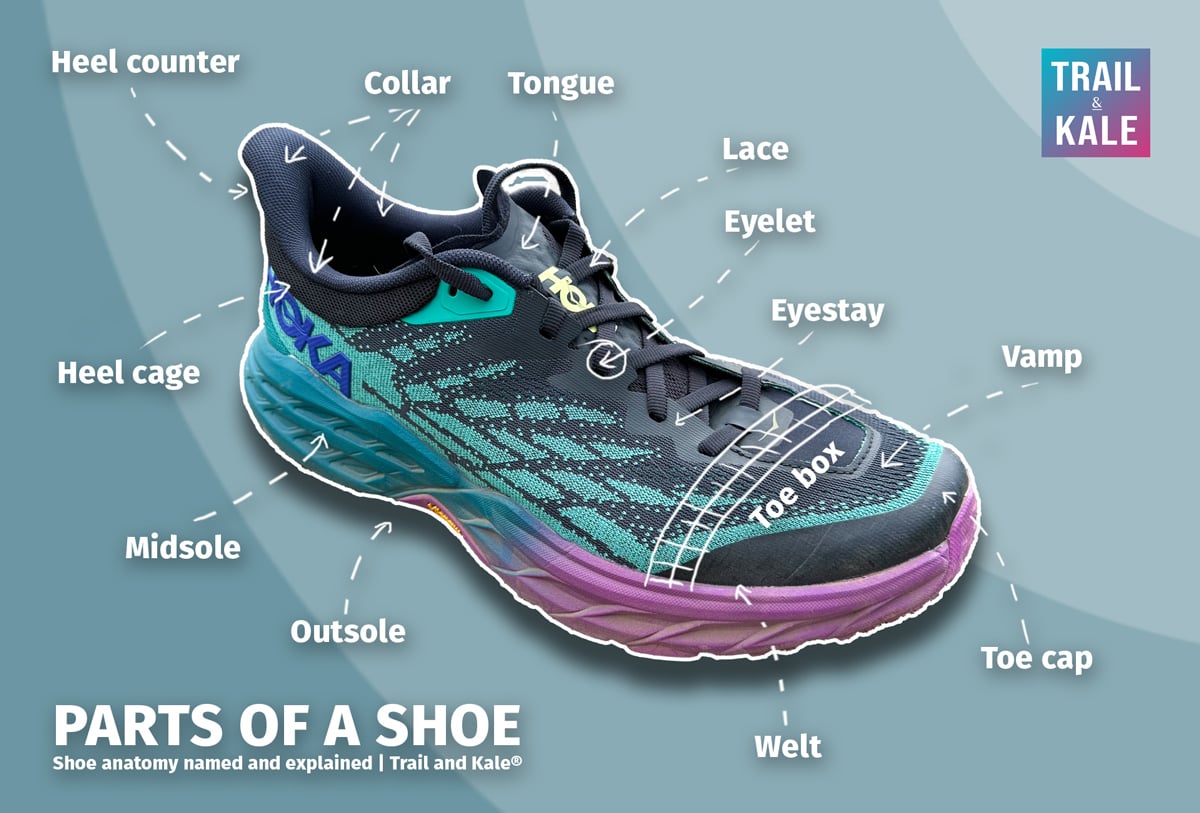
The shoe upper, which covers the top of your foot (as depicted in the shoe parts diagram above), serves as a vital component offering structure, support, and of course style.
Many running shoes nowadays will use a one piece upper as it negates the need for seems which can sometimes cause discomfort or compromise durability in stitching but traditionally the upper is made of multiple pieces or ‘zones’ of material, which I’ll go into in just a moment.
Understanding the different shoe parts, such as the vamp, quarter, collar, heel counter, tongue, and foxing, can help you appreciate the craftsmanship that goes into creating the perfect pair of running shoes, but also why they’re needed and how they benefit performance and comfort.
A shoe’s upper is crafted from various materials and serves as the foundation for the overall design of the footwear. Each part significantly contributes to comfort and durability, which I will examine in the various components of the shoe upper now.
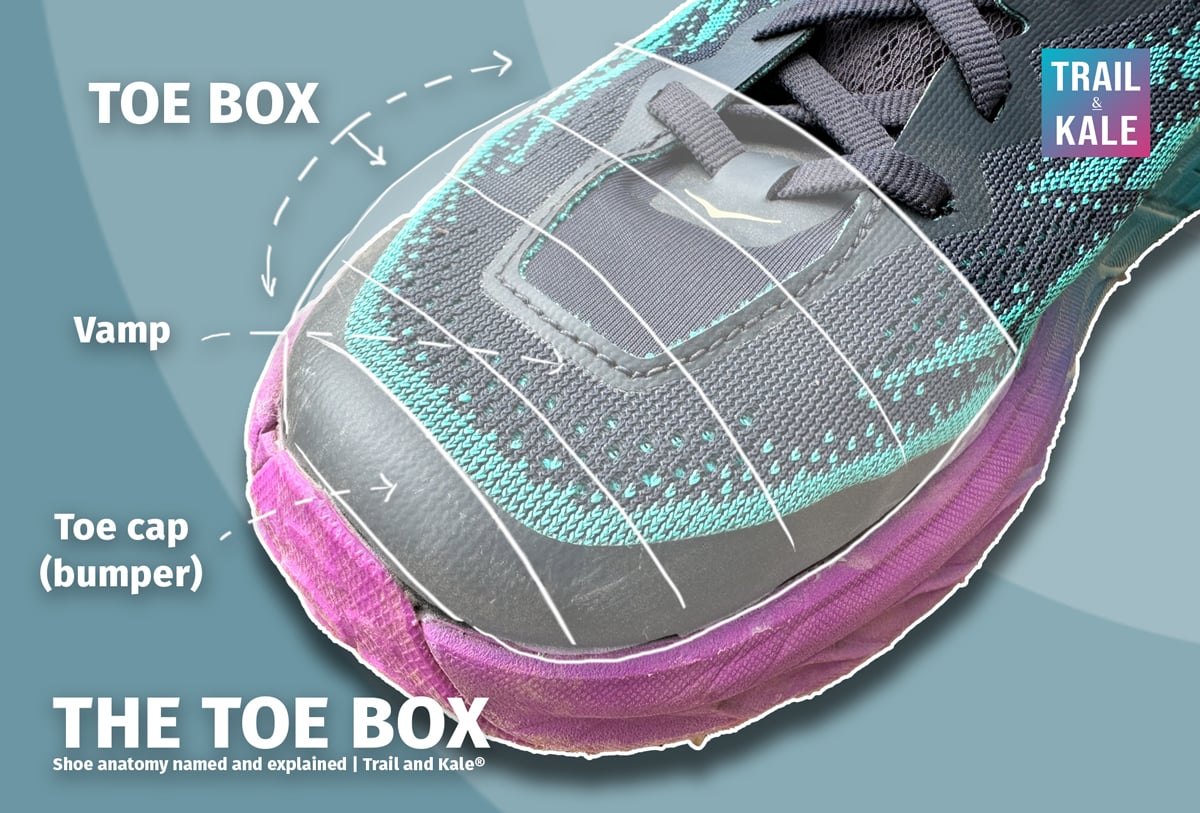
Toe box, toe cap, and vamp (fabric above the toe box)
The vamp (material that sits over the toe box), is the front panel of a shoe that covers the toes and extends to the rear quarter. Constructed from a range of technical materials, the vamp not only offers protection for your toes, and also breathability.
Some trail running shoes feature toe caps made of reinforced material, providing extra durability and protection for your toes, should you accidentally stub your toes on a rock or roots.
Quarter
The quarter is the rear portion of the shoe upper that wraps around the heel and connects to the vamp, providing stability and structure. The quarter helps to provide foot support, restricting unnecessary movement and assuring a secure, comfortable fit within the shoe.
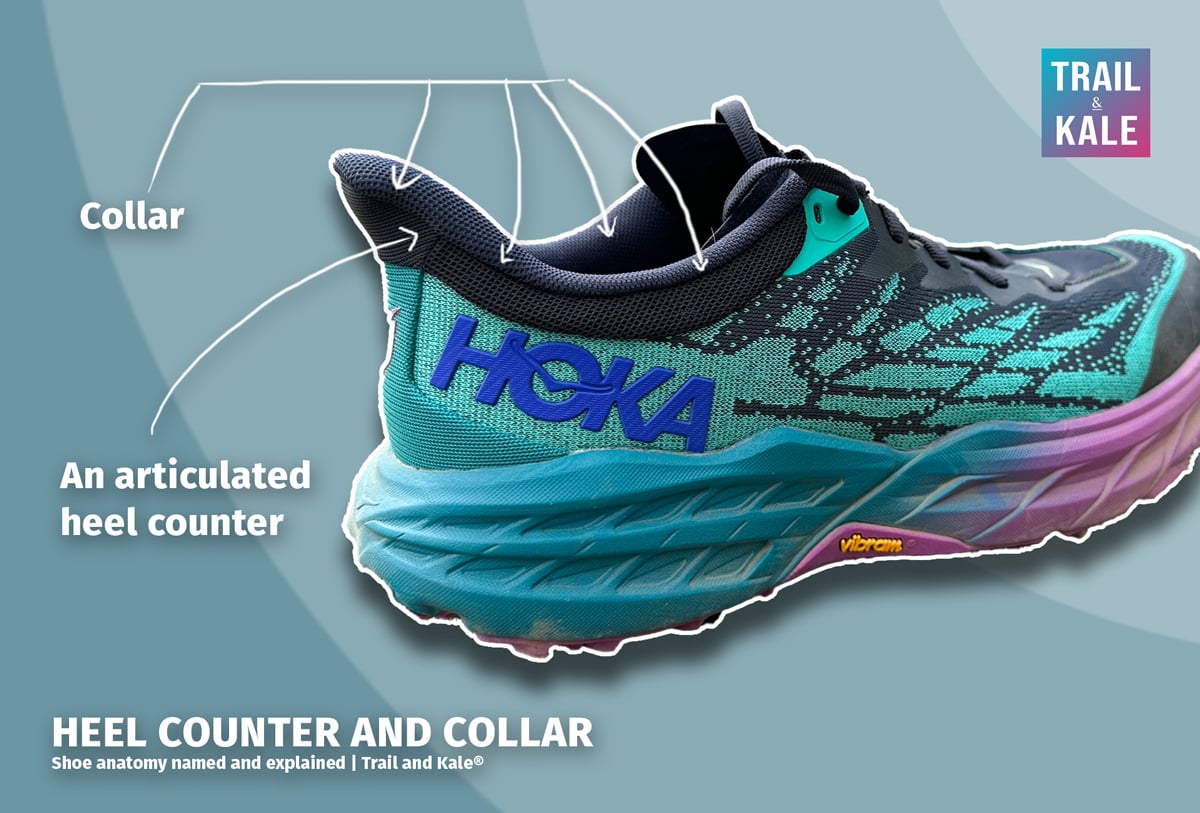
Heel Counter
The heel counter is a reinforcing material in the heel area of the shoe that offers support and stability. Some brands do extra reinforcement in zones and will sometimes refer to it as the ‘heel cage’ in trail running shoes.
This component aids in keeping the foot firmly in place while preventing undue movement but brands like HOKA, for example, sometime like to include an articulated heel that slopes backwards (see image above), making them easy to slip on and very comforting on your achilles heel, I personally love them.
Here’s an image of the heel counter from behind to show you the extent of it:

Collar
The collar is the uppermost portion of the quarter, typically padded for enhanced comfort, around your ankles and heels, where the foot is inserted. The padded collar provides stability and support around the ankle, enhancing ankle support and providing a comfortable fit when running.
You’ll notice this part of the shoe varies wildly from daily trainers that favor a soft, padded collar, to racing shoes that tend to have a much thinner, lightweight, and sometimes not quite as comfortable collar but one that certainly provides enhanced performance.
Tongue
Most people will know what the tongue of a shoe is. It runs beneath the eyestays and is attached to the vamp. Its primary function is to protect the foot from pressure points that may result from the shoelace or other components of the shoe, ensuring a comfortable and snug fit.
Some shoes, like certain slip-on styles, may not have tongues as such (the Arc’teryx Norvan SL running shoes pictured below are a good example of a slip on style running shoe), while others, such as dress shoes, may feature a more traditional design.
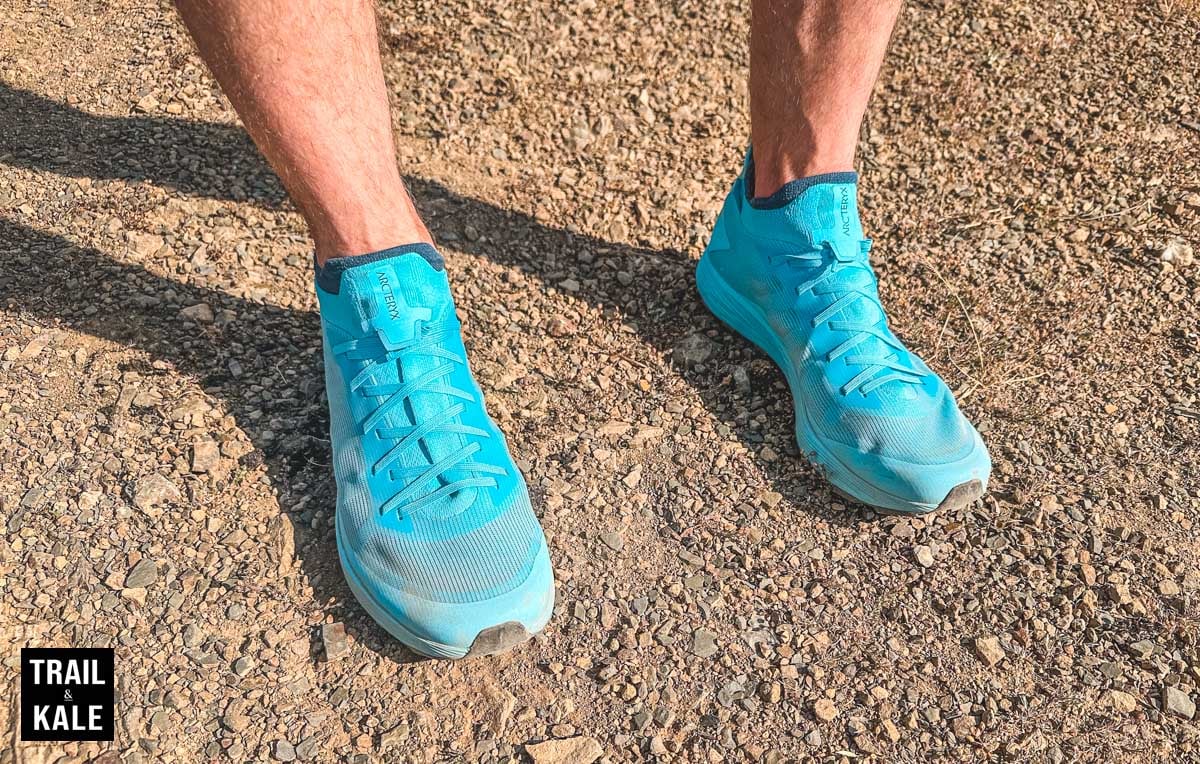
Foxing
Foxing is a strip that wraps around the sole’s sidewall, providing reinforcement and protection or sometimes serving as decoration. This shoe part contributes to the overall durability and aesthetics of the footwear.
The 3 shoe parts that make up a the sole
The shoe sole provides comfort and support and is very significant for day-to-day activities and sports performance.
The shoe sole comprises the insole, midsole, and outsole, each playing a crucial role in providing cushioning, support, and protection for your feet. It’s worth noting that in most running shoes nowadays, you will be able to remove the insole to further customise the fit of your shoes to your arch and foot shape; here are our top recommended running insoles.
Understanding the construction of the shoe sole and the materials used in each layer will help you appreciate the thought and effort that goes into creating footwear that offers maximum cushioning, responsiveness, comfort and support.
1. Insole
The insole is the inner layer of the shoe that extends from toe to heel, providing cushioning and support. Often made of soft foam materials, the insole serves as a comfortable layer between the midsole and your foot, offering additional support to the foot’s sole and arch.
As already mentioned, some insoles are removable, making them easy to clean and allowing for orthotic inserts to be added for enhanced comfort and support.
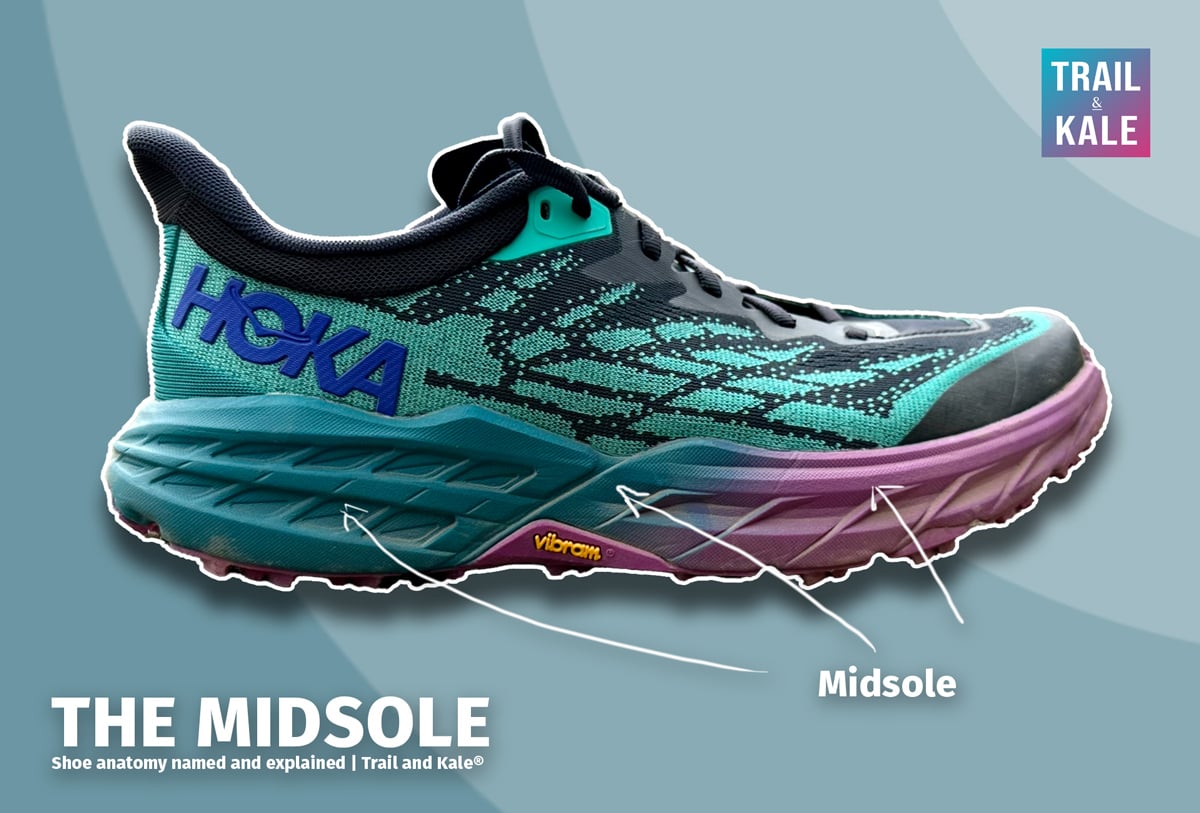
2. Midsole
The midsole is the layer situated between the insole and outsole, providing cushioning, shock absorption, responsiveness, and stability.
You’ll see all sorts of names thrown out there for various midsole foams/technologies but a couple of the high performance ones available from different brands are as follows:
- PEBA foam has incredible energy return and durability and is made with the Pebax plastic polymer. You’ll see this foam in premium tempo or race day shoes.
- Helion foam is what On’s proprietary Cloudtec midsole uses. Learn more about the best On running shoes and their proprietary technologies next.
- ProFly is HOKA’s Midsole system which is a combination of dual density foams. ProFly X add a carbon fiber or PEBAX plate to the midsole. Learn more about the best HOKA running shoes and their proprietary technologies next.
- DNA Loft V2 is what Brooks calls their high performance midsole foam.
- PWRRUN+ PWRRUNPB is Saucony’s name for their performance midsole foam and PWRRUN PB is their race day midsole foam crafted with a proprietary blend of PEBA polymers.
- ZoomX is Nike’s lightest foam, providing more cushioning without the weight gain. And the list could go on…
Some tempo and most race day running shoes also include a Pebax or carbon fiber plate in the midsole.
Additionally, the midsole helps determine the heel-to-toe drop and stack height of a shoe, factors that can influence overall comfort, performance, control, and feel. A shoe’s drop can also affect running form, for the better or worse.
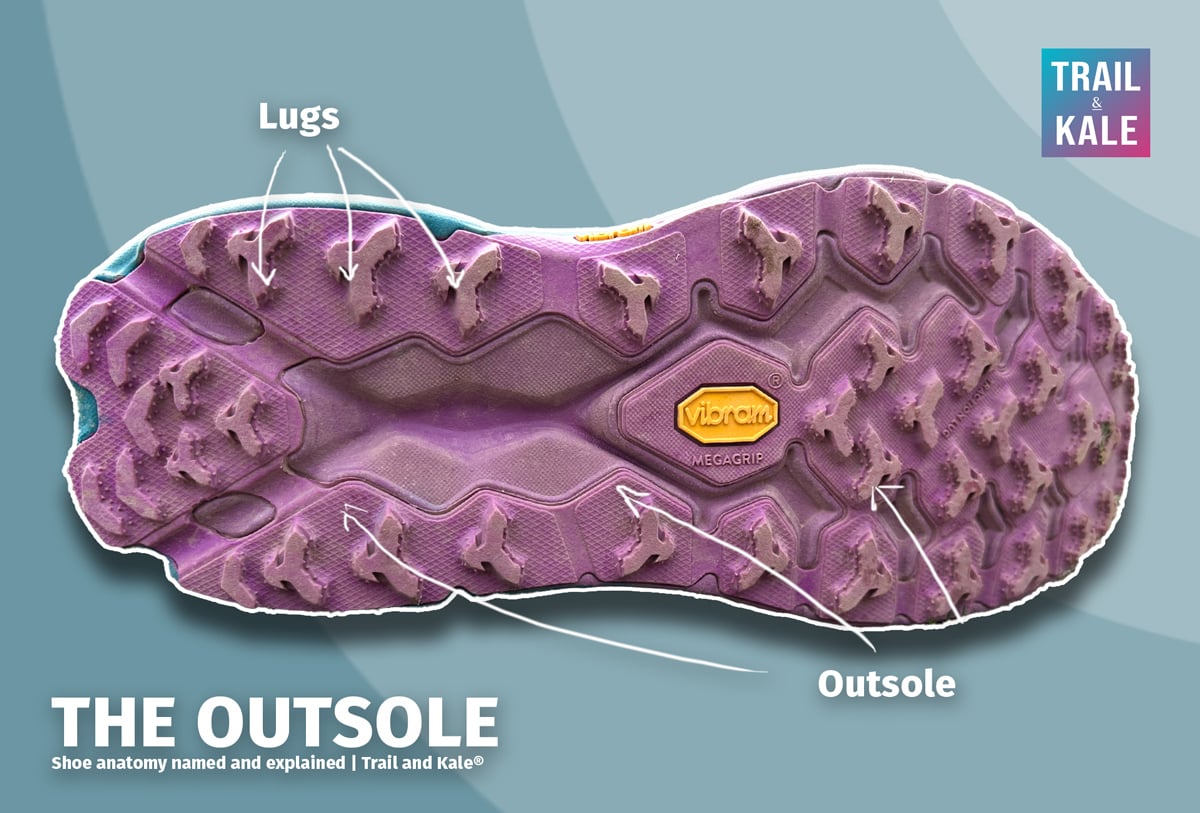
3. Outsole
The outsole is the bottom part of the shoe that comes into contact with the ground, providing traction and protection. Crafted from various rubber compound materials, the outsole’s design elements, including the tread pattern and depth of the grooves or lugs if you run trails, help increase grip and prevent slipping on various surfaces and weather conditions.
Different brands use different rubber compounds and tread patterns. For example, in the trail running world, HOKA has their Megagrip outsole that is designed and manufactured by Vibram, On has their MissionGrip, and Salomon has their Contagrip – all excellent in their own rights.
Additionally, the toe spring or ‘rocker’, an upward rise or curve of the sole at the forefoot (and the rear), aids in the rolling off of the forefoot for a smoother stride, while the heel seat provides support and stability.
Welt
The welt is a strip of material stitched around the edge of the upper’s base for better attachment of the outer sole. The welt securely attaches the upper part of the shoe to the sole, providing strength, and durability.
Most running shoes tend to do away with the welt and opt for a more streamlined, lightweight attachment hidden under the midsole.
Inside the shoe you find the lining and padding
Various linings and padding, such as collar padding, tongue lining, and counter lining, enhance the shoe’s comfort by providing additional cushioning and support inside the shoe. These components work together to ensure your feet remain comfortable and protected during daily activities and sports performance.
Let’s take a closer look at the different types of linings and padding found inside a shoe and their roles in providing optimal comfort.
Collar Padding
Collar padding offers cushioning and support around the ankle, reducing friction and irritation to prevent discomfort and blisters.
Moreover, the padding contributes to stabilizing the foot and enhancing the overall fit, thereby augmenting comfort during movement.
Tongue Lining
The tongue lining helps distribute the pressure of the shoe’s closure evenly across the top of the foot, preventing the laces from rubbing or adding pressure to the foot, thus improving the overall comfort of the shoe.
Counter Lining
Counter lining is a material used to line the back part of the shoe, offering additional support and comfort. The counter lining serves to retain the shoe’s shape and offer support to the heel, ensuring a proper fit and comfort.
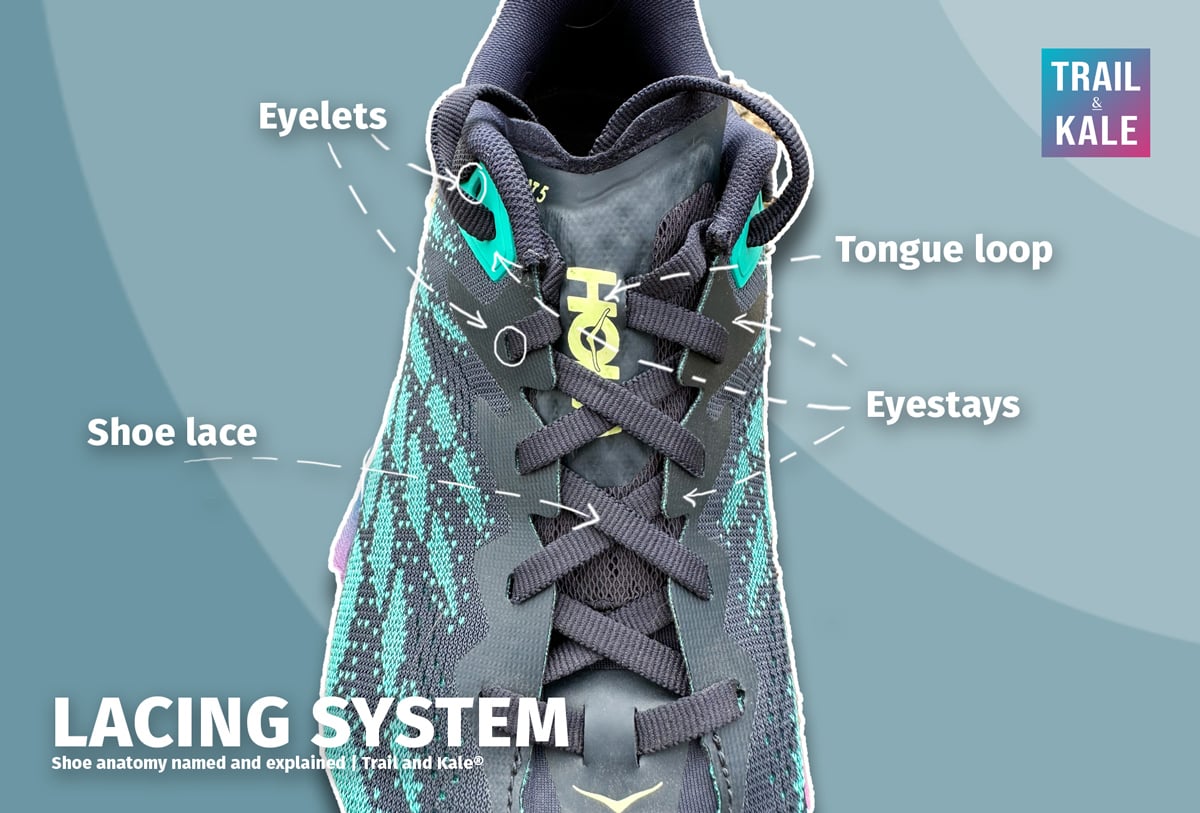
Shoe fastening systems
Shoes are designed for a secure fit on your feet, with different fastening systems playing a significant part in ensuring this. Laces, boa systems, eyelets, eyestays, and hooks are essential components of shoe fastening systems that ensure a proper fit and prevent your feet from slipping out of your shoes.
These are the different types of shoe fastening systems and how their combined effort to keep your shoes firmly on your feet.
Laces
Laces, also known as shoe lace, are strings or cords that pass through eyelets or hooks to tighten the shoe around the foot.
Lacing techniques play an important part in the fit and function of lace up shoes. Different lacing methods can provide additional space or alleviate tension, depending on the desired fit for a lace up shoe.
Furthermore, the style of laces, such as flat woven, stretch, or high-tech laces, can affect fit, performance, and comfort.
Some popular modern lacing systems include:
- Salomon’s Quick Lace System (learn more at Salomon.com)
- The BOA Lacing system (learn more about BOA systems)
- On’s Speed Laces as seen on the On Cloud 5 (my video demonstration of them)
Eyelets and Eyestays
Eyelets are holes in the shoe upper, often reinforced with strong plastic, through which laces pass. Eyelets reinforced with eyestays (the material that secures eyelets in place), safeguard the upper (top of the shoe) structure and reduce the chance of tearing or premature wear and tear.
Hooks
Hooks, also known as speed hooks, are designed for a more efficient adjustment and securing of laces. Generally, they are arranged in sequence along the top flaps on either side of the shoe, and the laces are woven around each hook, allowing for convenient tightening and loosening.
Shoe hooks are typically fabricated from metal, such as stainless steel or brass, and can be found in hiking boots and other types of footwear that require a snug fit.
More shoe features and terminology
Beyond the basic components of a shoe, unique features and terminology enhance footwear with additional protection, support, and style. Some of these features include:
- Heel tab or loop: Makes putting on yor shoes much easier as you can put your finger through the loop and slip the shoes on.
- Heel cage: Enforced materials around the heel counter area to help lock your heel in place to help enhance stability and support.
- Mudguard or Gaiter: Helps to keep dirt and debris from entering the shoe (see the photo below for an example).
- Shoe last: Determines the shape and fit of the shoe, usually formed with a mold.
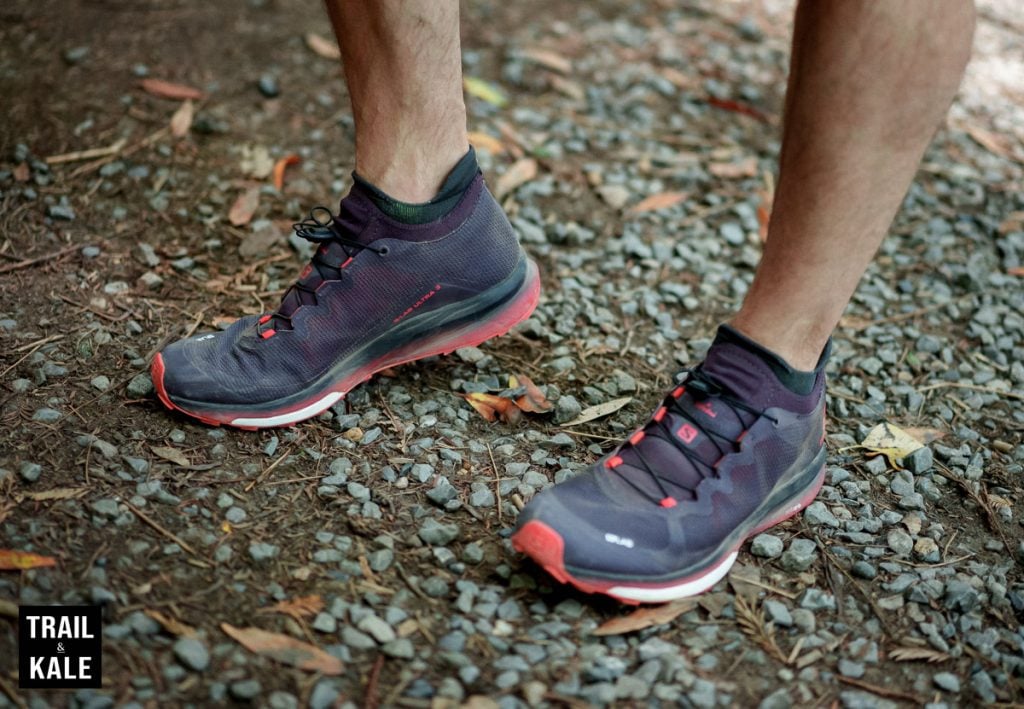
I hope you enjoyed reading this post, now go and show off to your friends by dropping some of these terms into conversation on your next run. 😀 As always drop any questions in the comments below.

![14+ Best On Running Shoes [2024] Ranked With Reviews: Ultimate On Cloud Buyer’s Guide 14+ Best On Running Shoes [2024] Ranked With Reviews: Ultimate On Cloud Buyer’s Guide](https://www.trailandkale.com/wp-content/uploads/2024/05/Best-On-Running-Shoes-of-2024-110x75.webp)

![10 Best Running Shoes of 2024 [Daily Trainer Category] 10 Best Running Shoes of 2024 [Daily Trainer Category]](https://www.trailandkale.com/wp-content/uploads/2024/02/Best-running-shoes-2024-Daily-Trainers-Category-110x75.webp)
![The Best Trail Running Shoes [2024] The Best Trail Running Shoes [2024]](https://www.trailandkale.com/wp-content/uploads/2024/02/best-trail-running-shoes-Trail-and-Kale-Recommends-2024-110x75.webp)
